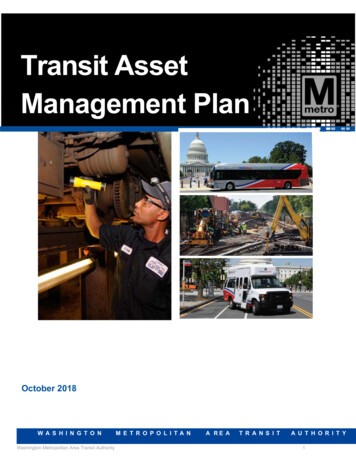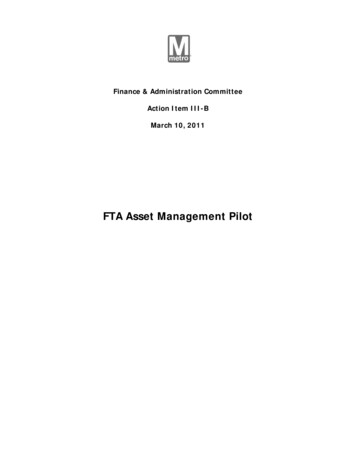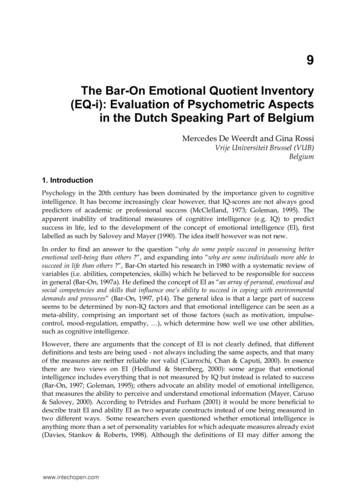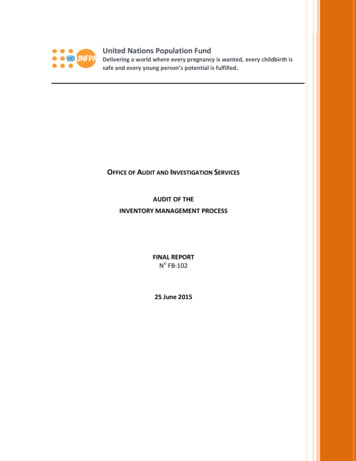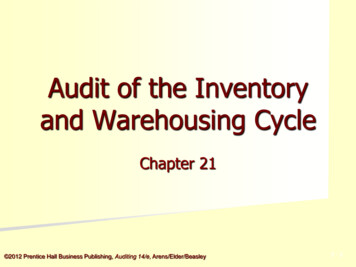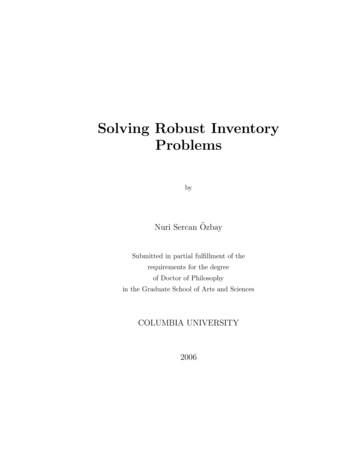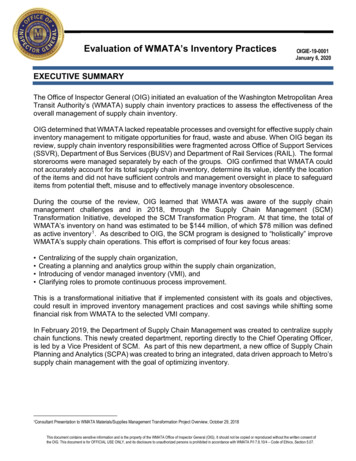
Transcription
IG reEvaluation of WMATA’s Inventory PracticesOIGIE-19-0001January 6, 2020EXECUTIVE SUMMARYThe Office of Inspector General (OIG) initiated an evaluation of the Washington Metropolitan AreaTransit Authority’s (WMATA) supply chain inventory practices to assess the effectiveness of theoverall management of supply chain inventory.OIG determined that WMATA lacked repeatable processes and oversight for effective supply chaininventory management to mitigate opportunities for fraud, waste and abuse. When OIG began itsreview, supply chain inventory responsibilities were fragmented across Office of Support Services(SSVR), Department of Bus Services (BUSV) and Department of Rail Services (RAIL). The formalstorerooms were managed separately by each of the groups. OIG confirmed that WMATA couldnot accurately account for its total supply chain inventory, determine its value, identify the locationof the items and did not have sufficient controls and management oversight in place to safeguarditems from potential theft, misuse and to effectively manage inventory obsolescence.During the course of the review, OIG learned that WMATA was aware of the supply chainmanagement challenges and in 2018, through the Supply Chain Management (SCM)Transformation Initiative, developed the SCM Transformation Program. At that time, the total ofWMATA’s inventory on hand was estimated to be 144 million, of which 78 million was definedas active inventory 1. As described to OIG, the SCM program is designed to “holistically” improveWMATA’s supply chain operations. This effort is comprised of four key focus areas: Centralizing of the supply chain organization,Creating a planning and analytics group within the supply chain organization,Introducing of vendor managed inventory (VMI), andClarifying roles to promote continuous process improvement.This is a transformational initiative that if implemented consistent with its goals and objectives,could result in improved inventory management practices and cost savings while shifting somefinancial risk from WMATA to the selected VMI company.In February 2019, the Department of Supply Chain Management was created to centralize supplychain functions. This newly created department, reporting directly to the Chief Operating Officer,is led by a Vice President of SCM. As part of this new department, a new office of Supply ChainPlanning and Analytics (SCPA) was created to bring an integrated, data driven approach to Metro’ssupply chain management with the goal of optimizing inventory.1ConsultantPresentation to WMATA Materials/Supplies Management Transformation Project Overview, October 29, 2018This document contains sensitive information and is the property of the WMATA Office of Inspector General (OIG). It should not be copied or reproduced without the written consent ofthe OIG. This document is for OFFICIAL USE ONLY, and its disclosure to unauthorized persons is prohibited in accordance with WMATA P/I 7.8.10/4 – Code of Ethics, Section 5.07.
Evaluation of WMATA’s Inventory Practices (OIGI-19-0001)Other areas of the SCM effort are in progress and are at different stages of implementation.Coordination of support departments such as Information Technology (IT) and Procurement(PRMT) will be required to achieve full implementation. Lack of a coordinated, timely responsemay result in delays of moving one or more of the focus areas forward and could jeopardize theprograms’ outcomes.OIG visited storage facilities, overseen by other departments outside of the SCM department, inwhich, parts, equipment and items are stored. These items included those procured as part ofcapital projects and operational readiness. Points of contact for these locations were sometimeshard to locate, and there was no centralized list of content.OIG determined that WMATA, through the SCM program, has established a plan and has takenactions to build a foundation to transform and improve the SCM process. Elements of the planhave been completed as part of the program’s implementation. Continued implementation of theremaining program elements is on-going and is being tracked against plan milestones. It isimportant to the success of the initiative that going forward WMATA implement the remainingprogram elements timely.OIG recommendations in this report reflect our independent assessment and the on-going effortby SCM program owners. OIG will continue to conduct follow-up activities as the SCM programmoves towards full implementation.This evaluation was conducted in accordance with the Quality Standards for Inspection andEvaluation issued by the Council of the Inspectors General on Integrity and Efficiency.MANAGEMENT’S RESPONSEWMATA COO Management responded to OIG in a memorandum dated December 4, 2019 and concurswith the OIG recommendations in the report. Management also reported that as part of the Supply ChainTransformation project, inventory management has been centralized to apply consistent standards andprocesses across rail, bus, and infrastructure under a single supply chain management function; andcontinues to move forward with other elements of the program. Management has committed to continueits efforts to ensure that WMATA’s supply chain practices are standardized and strenghtened in a holisticmanner.This document contains sensitive information and is the property of the WMATA Office of Inspector General (OIG). It should not be copied or reproduced without the written consent ofthe OIG. This document is for OFFICIAL USE ONLY, and its disclosure to unauthorized persons is prohibited in accordance with WMATA P/I 7.8.10/4 – Code of Ethics, Section 5.07.
Evaluation of WMATA’s Inventory Practices (OIGI-19-0001)TABLE OF CONTENTSBACKGROUND, METHODOLOGY & SCOPE . 1WHAT WE FOUND . 3RECOMMENDATIONS . 9MANAGEMENT’S RESPONSE . .10This document contains sensitive information and is the property of the WMATA Office of Inspector General (OIG). It should not be copied or reproduced without the written consent ofthe OIG. This document is for OFFICIAL USE ONLY, and its disclosure to unauthorized persons is prohibited in accordance with WMATA P/I 7.8.10/4 – Code of Ethics, Section 5.07
Evaluation of WMATA’s Inventory Practices (OIGI-19-0001)BACKGROUND, METHODOLOGY & SCOPEOIG initiated an evaluation of WMATA’s supply chain inventory practices to assess theeffectiveness of the overall management of supply chain inventory. As part of the evaluation, OIGreviewed prior reports and findings issued by OIG, the Transit Asset Management Office (TAMO);the Office of Quality Assurance, Internal Compliance and Oversight (QICO); and the Office ofOperations, Budget, Performance & Planning (OBPP). OIG also met with various internalstakeholders and their consultants to gain an understanding of the processes, visited warehousesand reviewed selected inventory items at the main Storeroom 400. Through this process, OIGlearned about the purpose and scope of two separate ongoing WMATA initiatives relating toinventory processes and asset controls.OIG also met with other transit OIG counterparts to understand their experience and lessonslearned from similar supply chain management initiatives specific to their transition to VMI. Whileanother transit OIG reported that its agency did garner better accountability and improved internalcontrol, the initial cost savings projection did not initially materialize because the authority hadother procurement paths that in some cases produced greater cost savings than the VMI process.That OIG further cautioned that it could take a longer period of time, in their case up to three years,after the startup of a VMI before true cost savings could be assessed.OIG reviewed MAXIMO data, which is the supply chain management system of record to recordand request inventory. This system is not consistently used when ordering through purchasecards (P-Cards) because the receiver, outside of the supply chain, does not consistently enter theinformation.As part of the evaluation, OIG visited warehousing facilities including the main Storeroom 400managed by the Supply Chain Management department. The OIG also visited Storeroom 350 andremote facilities,. OIGlearned that these facilities are controlled by departments outside of SCM.-2This document contains sensitive information and is the property of the WMATA Office of Inspector General (OIG). It should not be copied or reproduced without the written consent ofthe OIG. This document is for OFFICIAL USE ONLY, and its disclosure to unauthorized persons is prohibited in accordance with WMATA P/I 7.8.10/4 – Code of Ethics, Section 5.07
Evaluation of WMATA’s Inventory Practices (OIGI-19-0001)WHAT WE FOUNDThe OIG determined that WMATA lacked repeatable processes and oversight for effective supplychain inventory management to mitigate opportunities for fraud, waste and abuse. Repeatableprocesses are important to ensure efficiency, quality, consistency and measurable outcomes.When OIG began its review, supply chain inventory responsibilities were fragmented acrossSSVR, BUSV and RAIL. The formal storerooms were managed separately by each of the groups.OIG confirmed that WMATA could not accurately account for its total supply chain inventory ordetermine its value or location. OIG also confirmed that WMATA did not have sufficient controlsor management oversight in place to safeguard items from potential theft and misuse, or tomanage its obsolescence process effectively.MAXIMOInventory is purchased with long-term contracts, with non-contract procurements, and through theuse of P-Card purchases. According to SCM, purchases are not always captured in MAXIMOwhich is the system of record. In addition, they advised that all inventory transactions shouldinitially be received and entered into MAXIMO. Operations maintenance personnel should thenrequest inventory through MAXIMO work orders.As part of this evaluation, we reviewed MAXIMO data and confirmed that total inventory on handcould not be determined with a high degree of accuracy from MAXIMO because MAXIMO doesnot provide a single source of data for all inventory transactions and impedes reconciliation toPeopleSoft, which contains the procurement financial data. Data integrity is a challenge and SCMbelieves it will be improved through the centralization of SCM, training of supply chain operationsand maintenance personnel, systems up-grades to MAXIMO, and the introduction of the VMI.SCM has taken actions to turn on additional tracking capabilities in MAXIMO as part of the overallenhancement plan to improve data capture and accuracy.Supply Chain Storerooms and Other Storage FacilitiesStoreroom 400 is the main SCM storeroom. There are 23 additional storerooms that supportmaterial and supplies inventory. Eleven of the 23 storerooms are supported and managed byBUSV; eight are supported and managed by RAIL, and the remaining four storerooms are sharedby both BUSV and RAIL. Storeroom 350 houses capital spares acquired through the Silver LinePhase 1 project. Since the centralization of the SCM, all storerooms are managed by supply chainmanagement.The OIG visited the main Storeroom 400, and Storeroom 350. The OIG also visited selectedremote storage facilities. The OIG found that not all these facilities were managed by supply chainpersonnel. Based on a listing of leased storage facilities and points of contacts provided by theWMATA Real Estate department, OIG noted instances where the POC information was not up todate, making it difficult for the OIG to determine a sole point of contact.There were some remote storage facilities identified that were controlled by the InfrastructureRenewal Program Group (IRPG). OIG also identified a storage facilitycontrolled by a previous WMATA vendor where WMATA inventory items were being maintained.Appendix 1 shows some of the items stored. For these locations, we found a lack ofinventory controls and accountability.-3-This document contains sensitive information and is the property of the WMATA Office of Inspector General (OIG). It should not be copied or reproduced without the written consent ofthe OIG. This document is for OFFICIAL USE ONLY, and its disclosure to unauthorized persons is prohibited in accordance with WMATA P/I 7.8.10/4 – Code of Ethics, Section 5.07.
Evaluation of WMATA’s Inventory Practices (OIGI-19-0001)OIG further determined that there was no clear responsibility for oversight and control of theseremote storage facilities. Items stored in these facilities were items purchased for capital projects,but not used; spare parts acquired as part of a large construction or system purchase contract,which eventually will be brought into inventory; or parts that could be cannibalized to repair agedequipment when parts were no longer available.The OIG determined that for thelocation there was no one actively engagedand responsible for the control and distribution of the items. OIG determined, through dataprovided by WMATA Real Estate that the lease for this facility began in September 2012, and thetotal cost for leasing this facility since the start of the lease has exceeded 800,000. The locationappeared to be used as a repository for a number of power parts and landscape equipment thatwere reported to have been stored there for a number of years. We also observed severalunopened boxes marked 2008. Pictures in Appendix 2 identify examples of the condition of thisfacility and some of the items stored at this location. Many of these items are stored outside andexposed to the elements. OIG could not determine whether some of these items were still inservice or waiting to be excessed.There was no centralized process to identify items being stored at these remote storage facilities.Therefore, WMATA has no ability to determine with accuracy, the quantity, value and type of itemson hand, which could result in items purchased that are already on hand, thus increasing the riskof fraud, waste or abuse. Access to those remote storage facilities was outside the control ofSCM. As a result, WMATA cannot effectively predict inventory and Capital project needs.The OIG found that through the Supply Chain Transformation Program, efforts are in process thatshould address many of the OIGs concerns identified. However, as SCM implements its program,there will be a continued need for sound governance, training, enabling technology, andstakeholder coordination so the program results are achieved and successful.The SCM program efforts began in 2018 and are comprised of four key focus areas:1.2.3.4.Centralization of the supply chain organizationSupply Chain Planning and Analytics, (SCPA)Vendor Managed inventory, VMIRole Clarity and Process ImprovementSupply Chain Organization CentralizationIn February 2019 2, WMATA announced the reorganization of Supply Chain Management with theestablishment of the Department of SCM, combining Metro’s material and supply functions withinBUSV, RAIL and SSVR. In addition, they have moved to a centralized and more visible supplychain management organization. The new offices within the supply chain managementorganization changes SCES to Supply Chain Management – Facilities and Warehousing (SCMF),and Bus Maintenance (BMNT) Storeroom and Material Logistics and Materials and InventoryPlanning (MIPN) to Supply Chain Management – BUSV and RAIL, respectively. It also created anOffice of Supply Chain Planning and Analytics (SCPA) to bring an integrated, data driven approachto Metro’s supply chain management with the goal of optimizing inventory. In addition to disparate2MetroStaff notice number 2019-007, dated February 7, 2019-4This document contains sensitive information and is the property of the WMATA Office of Inspector General (OIG). It should not be copied or reproduced without the written consent ofthe OIG. This document is for OFFICIAL USE ONLY, and its disclosure to unauthorized persons is prohibited in accordance with WMATA P/I 7.8.10/4 – Code of Ethics, Section 5.07.
Evaluation of WMATA’s Inventory Practices (OIGI-19-0001)management of storerooms supporting the separate functional areas, storeroom management willalso be centralized. Since the initial reorganization, SCM has further refined the supply chainorganization.Supply Chain Planning and AnalyticsThe supply chain process is largely a reactive process. According to SCM, the supply chaininventory is approximately 70% reactive and 30% predictive. As a result, this largely reactiveprocess impacts the ability to properly plan for inventory needs. The creation of the SCPA provideda dedicated resource to manage demand management capabilities to better predict its supplychain inventory needs. WMATA advised that the office will track predictive supply needs basedupon manufacturer’s service recommendations and internal maintenance data which allow theprocess to shift, in time, to a less reactive process.Focusing efforts on the Reliability Centered Maintenance (RCM), which is an industry standardprocess, ensures that assets continue to perform at safe levels based upon a predictivemaintenance process. This should, in time, enhance WMATA’s capability for predictive inventorydemand projections. This capability would increase operational readiness and produce costsavings if implemented correctly. This process will require RAIL, BUSV and SSRV maintenanceoffices to provide advanced maintenance planning information over and beyond themanufacturer’s required scheduled maintenance over the lifecycle of the asset to the Office ofSupply Chain Planning and Analytics. This data, as reported to the OIG, will be used to conductpredictive analytics and forecasting to determine when parts will be needed. This is an examplewhere the success of this process is predicated on resources and input from outside of the supplychain.Vendor Managed Inventory (VMI)WMATA is in the process of moving towards a VMI process. According to SCM, the first area tobe introduced to VMI will be commodities inventory, which was estimated at 20 million 3 . Theselection of this category of inventory will assist in establishing baseline processes to use asadditional inventory categories are moved to VMI.OIG has been advised that when VMI is implemented, there will be a transfer of financial risk fromWMATA to the selected VMI company. That company will assist in right-sizing inventory, and willassist WMATA in only paying for the items when used. In addition, it will also help with vendorconsolidation. The VMI vendor will supply WMATA with parts and inventory on more of a “just intime” basis. Over time, according to WMATA, this should result in maintaining less inventory onhand and reducing handling/overhead costs. WMATA has engaged a consultant, who has ledsimilar VMI initiatives within the transit industry, to support this effort. We were advised by SCMand OBPP that implementation of this initiative is anticipated to take 12 to 18 months once avendor is selected and onboard. SCM requires timely support from PRMT in procuring a VMIvendor. Delay in this process could significantly impact the progress and success of the program.3ConsultantPresentation to WMATA Materials/Supplies Management Transformation Project Overview, October 29, 2018.-5This document contains sensitive information and is the property of the WMATA Office of Inspector General (OIG). It should not be copied or reproduced without the written consent ofthe OIG. This document is for OFFICIAL USE ONLY, and its disclosure to unauthorized persons is prohibited in accordance with WMATA P/I 7.8.10/4 – Code of Ethics, Section 5.07.
Evaluation of WMATA’s Inventory Prac
MAXIMO Inventory is purchased with long -term contracts, with non- contract procurements , and through the use of P-Card purchases. According to , purchases are not always captured in MAXIMO SCM which is the system of record. hey advised that all inventory transactions should In addition, t initia
